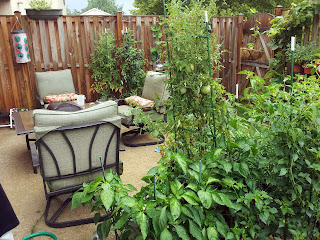A few new developments
A weekend not spent camping usually means a productive day or two in the garden. This weekend we didn’t go camping so we managed to tidy up a bit, pull weeds, move some of our squash and cucumber vines around and work in our compost bins a bit.
To those who are new to reading here, we do both traditional compost and Vermicompost.
Traditional composting is more or less just moving your kitchen scraps into a large vessel of some sort (we used a recycled cheap plastic trash can with a lid that has holes drilled in through the sides). Allow the scraps to slowly decompose and within three to six months you have new fertile soil, ready to feed your plants.
Vermicomposting is composting but with the help of worms. We use Red Wigglers because they are more tolerant of warmer temperatures. During the winter months they will survive, eat, and reproduce but very slowly. During the summer months as the temperatures rise the worms’ production rises. I noticed yesterday that the very hard cantaloupe rinds that Edward threw in there on the 20th of July are completely broken down, eaten through and has been turned into wonderful worm castings (aka worm poop).
When I have an open weekend I will be going through our bin to separate some of this lovely soil to be used in Vermicompost tea so I can extend it a bit.
In fact I have in mind a challenge!
~~~~~Miracle Grow vs. Vermicompost tea~~~~~
We have our two sickly, potted tomatoes that both look like they could use some help. So soon I will be using Miracle grow on one, Vermicompost tea on the other.
Stay tuned for the results!!
In the meanwhile, I had a few new discoveries around the garden.
Our winter squashes are all starting to produce female flowers! The first few that they have put out have quickly browned up and fallen off. This is completely normal as the plant is showing it is not quite mature enough to produce fruit. Think of it as an adolescent girl on the cusp of child bearing years.
 |
| See the rather thick curly stem with round like ball, that’s the female! |
We have now entered the stage (it appears) that our squashes are producing stout female flowers, capable of holding and supporting a rather large, bulky or heavy fruit.
Very cool!
This means our (possible) Marina di Chioggia, (possible) Black Futsu and the Delicata will all be bearing fruit soon! Now, I mention the Delicata with some excitement because while I am still guessing about the Marina di Chioggia and the Black Futsu I know for a fact that the squash (that was previously thought to be yet another weird cucumber) is in fact a Delicata.
Late last week after snapping numerous photos of all my many vines in the back yard I noticed that this one vines leaves look unlike any of the others. Of course I started first by looking over our seed list to narrow down which it could be.
I must say, Google is very cool. How nice is it that you can simply Google “Delicata squash leaves vine” and voila, come back with numerous results. Actually I should send that thanks to both Google and to other farmers and gardeners out there who like moi, post photos of their fields and gardens.
In about 15 minutes worth of work, sitting at my desk at work, rather bored because business has been slow as of late, I discovered that “yes indeed, I do have a Delicata growing in my yard!”
And to make things even better, I discovered yesterday, on my birthday that I have some female flowers growing on this vine too!
Last year, around late October, early November I visited the local Wegmans and spent around $7 for three of these lovely squashes so you can imagine how excited I am to be growing these now!
The only negative to a Delicata when storing though is that these do not have as hard of rinds so they do not store as long as some of the others (like the blue Hubbard, Marina di Chioggia, Black Futsu and other hard skinned winter squashes).
This just means we will have to have these eaten up probably no later than November to December.
Now, as I fall asleep, drive back and forth to work, take a shower or just do work around the house, I’ve contemplated our garden this year. Our mistakes and successes.
One thing I have come to realize is that while I was at first rather annoyed about the weird placement of the winter squash as well as the increased population of said winter squash, I’m now thinking it might be rather handy. After all, we can only eat so many fresh cucumber, so many canned pickles. But winter squash, well those hang on for some time. We will be eating winter squash well into late winter and possibly even into early spring. There is no preserving to be done for winter squash other than keeping it in a cool, somewhat humid area.
Many winter squashes stay edible for 5 to 6 months when kept in temperatures of about 50 to 55 degrees at about 70% humidity. So, some of our mistakes in our garden might actually make our lives just a tad bit easier for now and in winter.
Now, talking about winter and storing vegetables. This year I had the idea that, rather than building a temporary greenhouse/shelter we can just order some root vegetable seeds and then harvest them after the first few frosts. We do already have floating row covers so it’ll be a simple matter of just covering these when we see frost in the forecast.
I placed my order last week at Johnny Seeds for the following:





